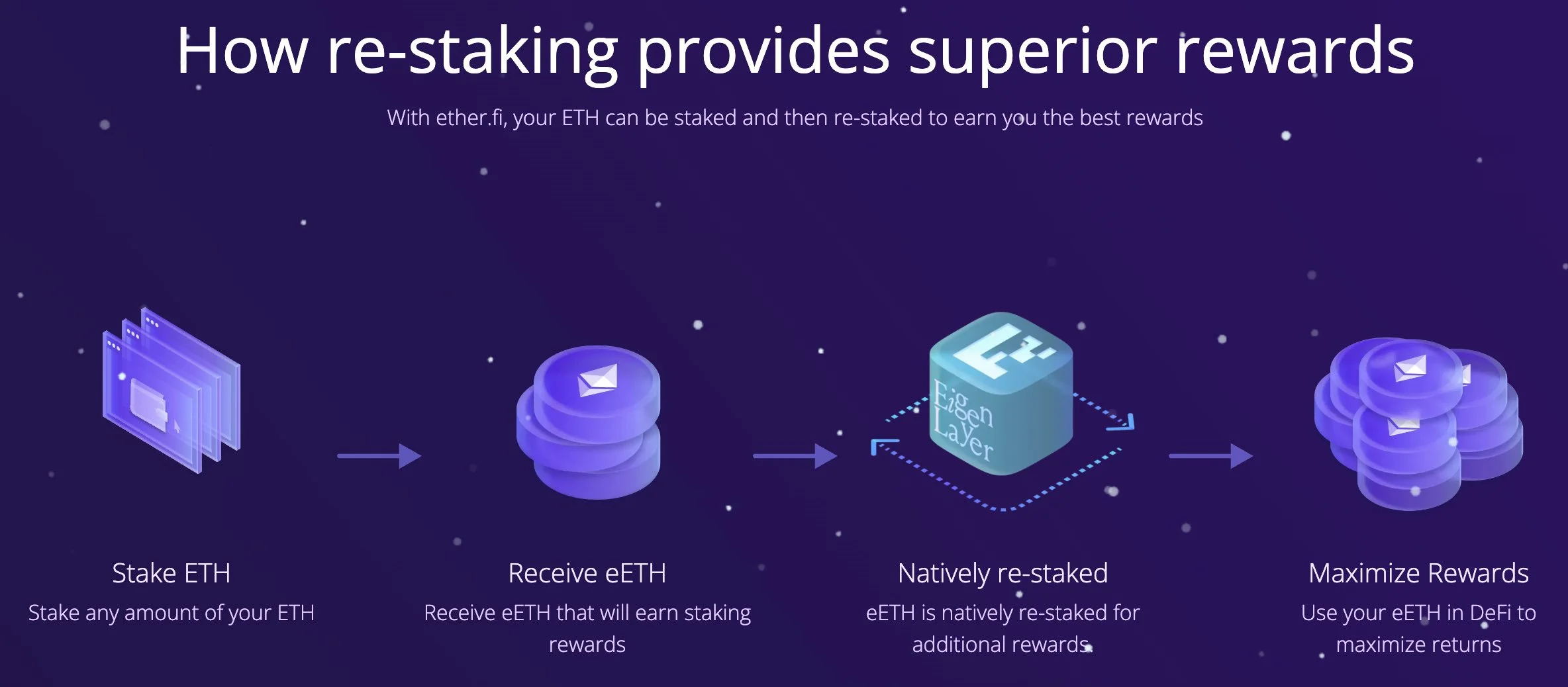Ether.fi
Ether.fi emerges as a formidable entity in the decentralized finance (DeFi) space, currently boasting a remarkable total value locked (TVL) of over $3.26 billion. This positions it as the largest liquid restaking protocol by TVL, illustrating its significant impact and adoption within the ecosystem.
But eETH is much more than that. Let’s dive in.
Ether.Fi tweet
None of the other LRT’s come close at the time of writing. Ether.Fi truly is building a behemoth.
Framework of Operation
Ether.fi's framework engages, much like EigenLayer: ETH stakers, node operators, and later service providers (AVSs).
Their first product Stake and now Liquid has had huge success with further use cases in the pipeline.
Delegated Staking Stage
For the big boys (institutions and whales). The protocol kickstarts with a delegated staking stage tailored for individuals willing to stake 32 ETH or more. Here, node operators present their proposals to run validator nodes. Upon ETH contribution by stakers, an auction process is initiated to select the suitable node operator for managing the validator. This innovative mechanism fosters the creation of withdrawal safes and issues two types of Non-Fungible Tokens (T-NFT and B-NFT), symbolizing the staker's entitlement and control over their staked ETH.
Liquidity Pool and eETH Phase
For the masses. Aiming to democratize Ethereum staking, Ether.fi introduces the liquidity pool phase. This phase caters to individuals holding less than 32 ETH or those preferring not to manage validator nodes directly. Participants can mint eETH by partaking in the liquidity pool, offering a streamlined and accessible avenue to engage in Ethereum staking.
Node Services Expansion
As more and more AVSs mature into production and are plugged into the EigenLayer ecosystem, EtherFi will select AVSs to provide security in ETH. Node Operators like us will run the new software and stakers will collect the rewards the AVSs pay out for security.
Ether.Fi has already promised to secure Lagrande and Aethos with 500M of staked ETH each.
With these AVS integrations, yields on LRTs can be boosted significantly.
Beyond Staking
Ether.fi aims to onboard the next billion users onto crypto, making DeFi easy, safe, and transparent. Their vision expands beyond their original liquid staking protocol, introducing a suite of three integrated products over the next 12–24 months: Stake, Liquid, and Cash. Stake enhances ETH restaking, Liquid offers a managed DeFi strategy vault for deploying assets to boost yield, and Cash plans to enable real-world spending and borrowing against ether.fi balances. This evolution reflects a shift towards comprehensive financial services under DAO governance, aiming to democratize and simplify crypto use.
Ether.Fi’s Liquid product has seen huge adoption and is the largest yield aggregator on defi llama at the time of writing.
Ether.fi's Distinction: Emphasis on Decentralization
Ether.fi sets itself apart through its unwavering commitment to decentralization. By implementing strategies such as Operation Solo Staker, incorporating DVT and self limiting, it further disperses Ethereum's node distribution across varied geographies; enhancing network decentralization. Additionally, Ether.fi is the only protocol where stakers retain key control, significantly mitigating counterparty risk for both node operators and the protocol itself.
Ether.Fi recently launched their DAO governance token $ETHFI. Holders will have a say in future protocol adaptions, grants, fees etc. This is the start of the decentralization of the protocol.
StakeCat's Support for Ether.fi
StakeCat's support for Ether.fi is deeply rooted in the shared value of decentralization. StakeCat aligns with Ether.fi's vision of a decentralized and secure Ethereum ecosystem, we love to leverage our expertise to contribute to the network's strength and diversity.
Conclusion
Ether.fi stands out in the DeFi landscape, not just for its impressive TVL but for its innovative approach to liquid staking, decentralization, and community engagement. StakeCat's support of Ether.Fi underscores our commitment to advancing these ideals, fostering a more inclusive, secure, and decentralized Ethereum ecosystem.




